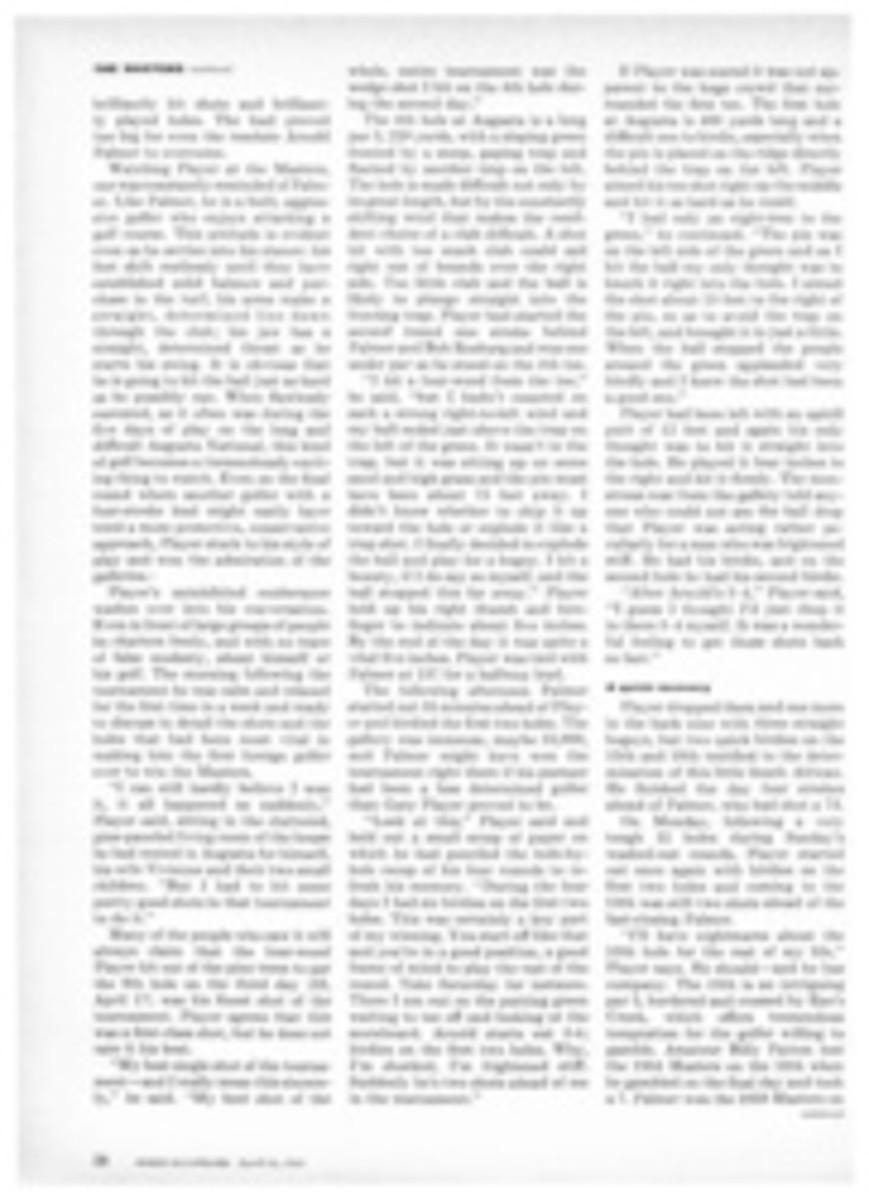
RIDING DOWN THE WIND
Three weeks ago on these pages, Olympic Yachting Champion George O'Day introduced the art of planing, in which light, flat-bottomed boats like the 5-0-5 (below) can be made to rise onto the surface of the water and skim along at triple the speed of conventional craft. Now O'Day, with his Olympic crewman Dave Smith, shows how to get even more speed out of a planing hull, first by wave riding and then by setting and handling a spinnaker. These advanced maneuvers are used only in downwind sailing, and require a more sensitive touch than the basic lessons of Part I, where the wind was coming from broadside or slightly ahead.
In the lakes and bays where planing boats usually are sailed, the waves tend to be short and choppy like the ones shown here. Unfortunately, these are the hardest to ride, since they lack power and hence cannot carry the boat any great distance or lift its speed more than three to four mph. Nevertheless, each wave, if ridden properly, can mean a gain of a few yards; and over the full course of a race, these yards can add up to victory. O'Day is particularly skillful at handling a boat in a choppy sea. As each wave approaches, he catches the crest, holds it for a moment, then drops off again, ready for the next one. So quickly do O'Day and Smith manipulate the tiller and sails that the entire sequence shown here takes no more than 10 seconds.
In a larger sea with more carrying power, the jobs of both the skipper and crew are much easier. The sequence can last for half a minute or more; and if the wind is blowing hard enough, a well-balanced boat can hold onto a crest for nearly a quarter of a mile, skidding down the face of the wave at 15 to 20 mph. A planing ride at these speeds is unlike anything else in small-boat racing. A flat wake hisses out astern as the boat surges forward with such steady power that she seems to be riding on steel rails. One false swing of the tiller, however, and this exhilarating charge downwind can come to a sudden, wet halt (see pages 50-51).
1 As wave approaches from left, O'Day pulls tiller to start stern swinging into crest.
2 With boat's stern toward swell, Smith and O'Day slack sails, get ready to hike out.
3 When crest reaches middle of hull, men pull hard on sails for added speed.
WAVES FROM THE SIDE
The first move in riding waves that come from the side (as shown here) is an abrupt turn to swing the broad stern of the boat into the crest. When the wave hits, the stern rises and the hull gathers speed as it starts to run down the front of the swell. To stay on the wave as long as possible, Smith and O'Day pump the sails in hard, and lean (hike) well out on the windward side, keeping their balance by tucking their toes under the canvas hiking straps, just as they did in the first planing demonstration in Part I.
Riding waves, boat turns 20° off course in order to catch swells.
WAVES FROM THE STERN
When the swells are coming in from behind, there is no need to make a violent change of course since both the boat and the wave system are going in the same general direction. However, when the first crest moves under the boat, the skipper should turn slightly off course in a gentle, even curve to keep the wind flowing into the sails at the best angle. Veering off like this also prolongs the ride by sending the hull slanting across the face of the wave rather than straight down it. Although the maneuvering of the boat in this situation is comparatively simple, the men aboard must be careful to keep their weight directly over the crest so the boat balances properly throughout the ride. This means they must slide forward and then backward inside the cockpit as the wave surges past. The movements of both crewmen must be smooth and steady, and their timing precise. Otherwise, the boat will wobble down into the trough, losing as much as 50% of its speed, and perhaps the race.
1 Between waves, boat planes along at 10 miles per hour. O'Day and Smith sit quietly in cockpit, ready to let out mainsail.
2 On crest, traveling now at 15 miles per hour, O'Day turns slightly off the wind as both men slide their weight forward.
3 Hanging on as crest starts to leave, O'Day gives 5-0-5 last burst of speed by quickly trimming both mainsail and jib.
4 Back in trough again, both men shift toward the rear of the cockpit as their boat returns to normal planing speed.
Shifting back and forth in cockpit, crewmen keep weight over peak of wave.
PLANING WITH A SPINNAKER
The spinnaker (right) is a powerful, full-bellied sail set before the mast to give extra speed going with the wind. Sailors of heavy conventional boats use spinnakers on virtually all downwind runs; but planing skippers use them less often for two reasons. First, the sail is so big that it can overpower a sensitive boat like the 5-0-5 when the wind freshens. Second, by tacking (e.g., zigzagging downwind), catching the waves and keeping the boat planing, a skipper like O'Day can often reach the finish line faster using a small jib than he would sailing a straight course under a spinnaker. In light and medium winds, however, O'Day finds that to keep the boat moving he must drop his jib and set the big sail. And in very light air he has to pump the spinnaker (below) to get the 5-0-5 up onto the surface where it can plane.
Technique of setting spinnaker is same for planing boat as it is for any small craft (SI, March 2, 1959). When wind strikes, sail spreads out and tends to lift upward. As spinnaker rises, Smith and O'Day pull back on lines, stretching sail so it catches as much air as possible. Going directly before wind (above), men balance boat by sitting on opposite sides of mast, swinging tiller constantly to meet subtle wind shifts, but moving sheets as little as possible to avoid spilling air from sail. When breeze moves decisively to one side, however, crewmen shift to windward (left) and trim spinnaker so that it stays full. Then if boat drops below planing speed, O'Day gets it moving again by pulling back hard on one corner of spinnaker. This quick pumping action gives the sail added lift, in same way small boy gets kite to fly higher by tugging on string.
SAILING OUT OF A CAPSIZE
No matter how good he is, sooner or later anyone who goes out in a sailboat turns over. But in a planing hull, a capsize does not mean the end of the race. Practically all planing boats have built-in flotation tanks, and since the hulls weigh so little, they float high in the water, even when swamped. If the crewmen learn to move fast enough, they can get their craft upright without dropping too far behind in the fleet. At left, the 5-0-5 has just gone over. As water pours into the cockpit, O'Day and Smith scramble to the high side to keep the mast from going under. Then they quickly pull the boat back on her feet, trim the sails, and by opening the trap-door bailers (below), have the 5-0-5 up and planing less than 30 seconds after she went over.
Knocked down by sudden gust, O'Day and Smith are already on high side of hull, ready to climb onto centerboard (below, right).
On the centerboard, Smith bounces hard to pull hull upright.
1 Mast and sail begin to rise out of water as both men put their full weight onto the centerboard.
2 Half recovered from knockdown, O'Day starts back into boat; Smith stays on centerboard.
3 O'Day clambers into cockpit while Smith, still hidden behind hull, continues to pull downward.
4 Once aboard, O'Day moves to far side of cockpit to balance hull while Smith climbs over gunwale.
5 Sails trimmed and bailers open, 5-0-5 drains herself dry as she quickly gets up to planing speed.
EIGHTEEN ILLUSTRATIONS
TONY RAVIELLI
ILLUSTRATION
TONY RAVIELLI
BAILERS OPEN
ILLUSTRATION
TONY RAVIELLI
BAILERS CLOSED

